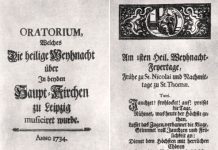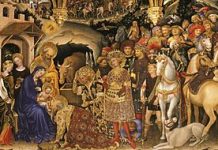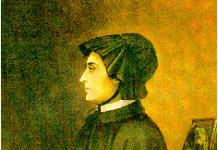I found an old picture of my father in an attic drawer. It was taken on the occasion of the St. Peter’s Altar Boy picnic on the steps of the Cathedral. There are about thirty altar boys in the picture with Fr. Morocco. I was pleased to find this picture, and it brought to my mind many of my own experiences as an altar boy in the late 60s, also at St Peter’s. As in my father’s time, there were thirty of us. Fr. O’Dette trained us, our duties being to ring the bell, carry the incense and sensor, and light the candles.
I recall the excitement that I felt when it was my turn to ring the bells or walk with the priest carrying the bucket as he sprinkled holy water on the congregation. But the greatest thrill of all was the incense. Being an altar boy gave me a chance to do things that we were not allowed to do at home. As young as eight years old I could light wooden matches and carry candles. One of the hardest jobs was to pour water from a huge pitcher onto a flat brass plate. This took real skill as the water would swirl around the polished brass and spill over the sides. It was a matter of pride to be able to do this with a steady hand under the critical eyes of my more experienced peers. On Sundays, the older boys took charge of the incense, water bowl, or bell, leaving us young lads to serve as Acolytes. It was only during the weekday Masses that we new altar boys could perform these duties.
My favourite Mass to serve was the 7:15 on weekday mornings. The other two daily mass times were 8:10 AM and 5:20 PM. The 5:20 was for people coming home from work, with most of these either on foot or riding bicycles. The 8:10 was the bishop’s Mass and was well attended. But the 7:15 was for people going to work. In the winter I used to walk to St. Peter’s in the dark before dawn and then, once inside, slowly bring the church to life by lighting the candles around the altar. There would be two of us assigned to serve, and for a ten-year-old it was an exciting adventure to meet up with a friend before breakfast. Sometimes, especially during Lent or Advent, there would be three or four altar boys; we used to challenge each other to go to Mass in the cold winter mornings.
During Mass itself, the sunlight would slowly start shining in through the stained glass windows, causing all the colours to dance in splendour all over the north and west walls, the altar, and the priest’s vestments. These coloured shadows would start high, near the ceiling, and then slowly drop down the walls as the sun rose. After Mass was finished, it was wonderful to emerge from the warm bath of soft lights into the bright sunny morning. I would run home for a porridge breakfast before school or, in the summer, before spending my day catching crayfish in Jackson’s Creek.
As altar boys, we got to skip class for training sessions, and on weekends we sometimes went ice fishing with Fr. Moran. These outings were highly prized perks of the job and, indeed, often the things that attracted us to be altar boys in the first place. Fr. Leahy came to our school and asked if any of the boys wanted to serve on the altar. Almost our entire cub pack and scout troop showed up at the first meeting. And, what seems remarkable in retrospect, everyone stayed!
Things began to change as I aged: I had missed the training in Latin that my older friends received, something I regret. I also recall the first day the bell was removed from the credence table, taken by a zealot priest to modernize the liturgy. After that, as each duty disappeared, so did the need for altar boys, and gradually our number diminished to nil.
All of these memories have come back to me, since I now have two boys serving on the altar at our parish in Lakefield. There, the bell, incense, and holy water are back. And, delightfully, so are the altar boys. Last Sunday, for instance, there were eight lads, a usual occurrence. These always divide up the duties so that everyone always has something to do, with the older boys looking after the young ones. And what makes me feel both proud and curiously wistful at the same time, my two boys can sing many of the old Latin prayers: the Sanctus, Agnus Dei, and even the Pater Noster—something I never learned how to do. It demonstrates a great truth of the Catholic revival: wherever the renewal succeeds, it is always a renewal of a timeless liturgy that appeals to the young.










